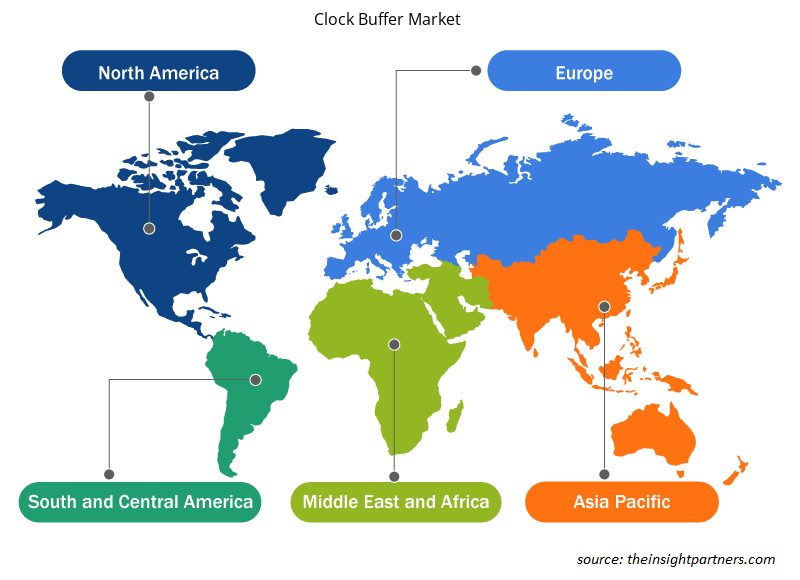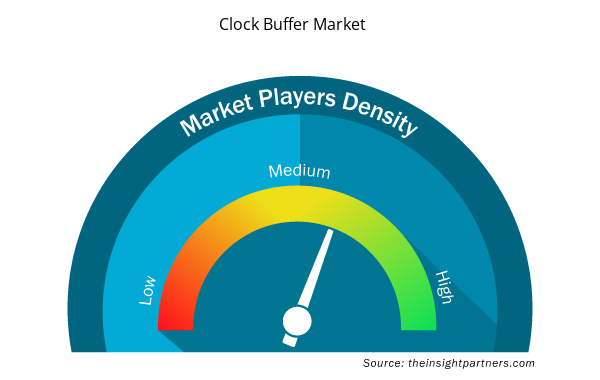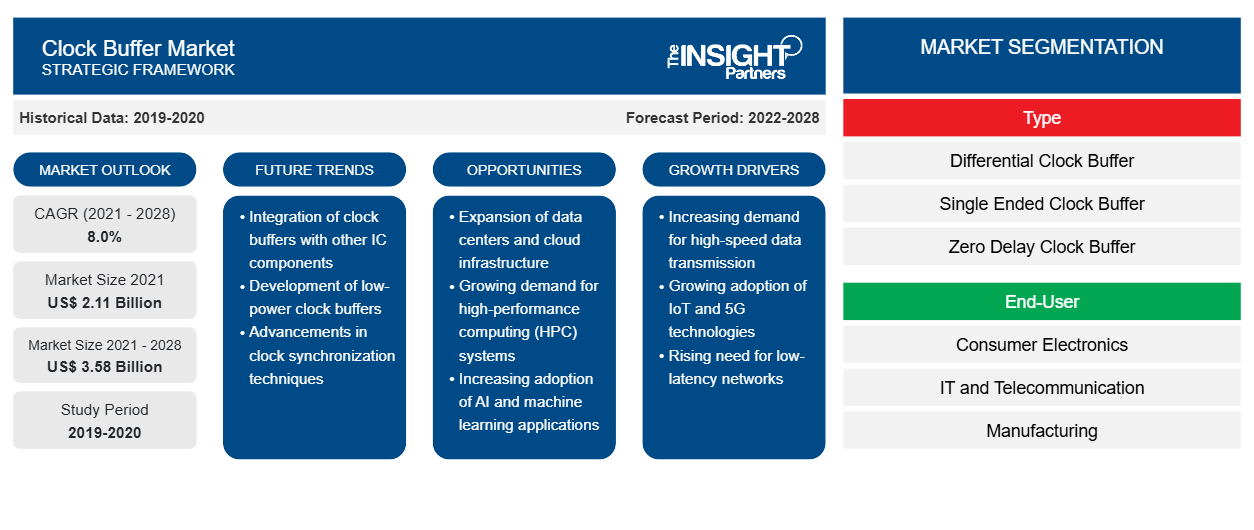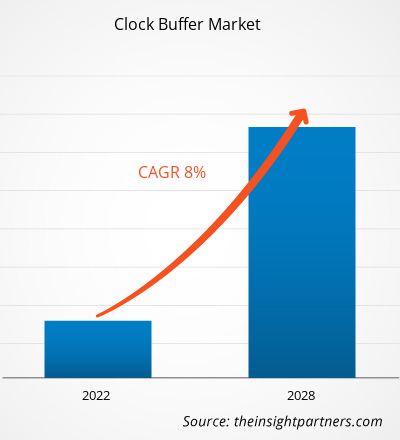Der Markt für Taktpuffer soll von 2.112,53 Millionen US-Dollar im Jahr 2021 auf 3.579,91 Millionen US-Dollar im Jahr 2028 anwachsen; von 2022 bis 2028 wird ein durchschnittliches jährliches Wachstum von 8,0 % erwartet.
Der globale Markt für Taktpuffer ist geografisch in Nordamerika, Europa, Asien-Pazifik, Naher Osten und Afrika sowie Südamerika unterteilt. Im Jahr 2021 führte Nordamerika die Marktanalyse für Taktpuffer mit einem Anteil von 40,5 % an, gefolgt von Asien-Pazifik und Europa.
In den letzten Jahren hat die Nachfrage nach Cloud Computing ein deutliches Wachstum erlebt, was die Verbreitung des Internets beschleunigt hat. Daher investieren viele ausländische Direktinvestitionen massives Kapital in Nordamerika, was sich positiv auf Cloud Computing auswirkt . Die US-Regierung hat viele Initiativen ergriffen, um die Unterhaltungselektronikbranche anzukurbeln. So hat die US-Regierung am 6. Mai 2022 einen neuen parteiübergreifenden Vorschlag vorgelegt, um den Leiterplattensektor des Landes anzukurbeln. Viele etablierte Unternehmen der Elektronikfertigungsbranche in den USA haben den Vorschlag begrüßt. Der Gesetzentwurf wird den CHIPS Act von 2021 und den American Printed Circuit Boards Act von 2022 unterstützen. Infolgedessen werden sich den wichtigsten Akteuren auf dem nordamerikanischen Markt für Taktpuffer in den kommenden Jahren lukrative Möglichkeiten bieten.
Der Markt für Taktpuffer im asiatisch-pazifischen Raum ist in Indien, China, Japan, Australien und den Rest des asiatisch-pazifischen Raums unterteilt. Viele Regierungen in der Region waren aufgrund der COVID-19-Krise gezwungen, ihre Ansätze zum Kauf von aufgerüsteten Geräten wie Desktops, Laptops und PCs sowie allgemeiner Serverausrüstung von bestimmten Lieferanten und Herstellern zu überarbeiten. Daher steigt die Nachfrage nach anderen Kommunikationssystemen wie Routern, Modems, drahtgebundenen und drahtlosen Elektroniksystemen (Panels) und anderen Peripheriegeräten, was viele lukrative Möglichkeiten für die wichtigsten Anbieter geschaffen hat, die den Markt für Taktpuffer bedienen. In Indien haben die Anbieter von Informations-, Kommunikations- und Technologiediensten und -lösungen aufgrund des Ausbruchs der COVID-19-Krise ihre Geschäftsmodelle auf Fernarbeit umgestellt. Darüber hinaus arbeiteten die Schulen und Hochschulen auch im Jahr 2022 weiterhin aus der Ferne, sodass der Bedarf an einem Computergerät für die Schüler von entscheidender Bedeutung ist. Einige Schüler, die zuvor Smartphones/Tablets für virtuellen Unterricht verwendet hatten, sind auf PCs umgestiegen, da diese Vorteile wie größere Bildschirme und Benutzerfreundlichkeit bieten, was sich positiv auf den Markt für Taktpuffer auswirkt.
Passen Sie diesen Bericht Ihren Anforderungen an
Sie erhalten kostenlos individuelle Anpassungen an jedem Bericht, einschließlich Teilen dieses Berichts oder einer Analyse auf Länderebene, eines Excel-Datenpakets sowie tolle Angebote und Rabatte für Start-ups und Universitäten.
- Holen Sie sich die wichtigsten Markttrends aus diesem Bericht.Dieses KOSTENLOSE Beispiel umfasst eine Datenanalyse von Markttrends bis hin zu Schätzungen und Prognosen.
Auswirkungen der COVID-19-Pandemie auf den Taktpuffermarkt
Dank der günstigen Regierungspolitik zur Förderung von Innovationen und Stärkung der Infrastrukturkapazitäten weist Nordamerika die höchste Akzeptanz und Entwicklungsrate neuer Technologien auf. Laut CBREs North American Data Center Trends Report 2020 war der Rechenzentrumssektor der Region im ersten Halbjahr 2020 stark, da die Unternehmen hybride IT-Infrastrukturen implementierten, um Remote-Arbeitskapazitäten zu entwickeln. Die COVID-19-Pandemie in Nordamerika hat Unternehmen gezwungen, eine Work-from-Home-Strategie (WFH) umzusetzen, um ihre Geschäftsprozesse während der Krise aufrechtzuerhalten, was die Nachfrage nach Big Data und Datenanalysen stärkte. Im Jahr 2020 erkundeten Unternehmen KI-Anwendungen und Big-Data-Analysen, um Benutzern Erkenntnisse zur Planung der Ressourcennutzung für spezifische Herausforderungen in der Medizinwissenschaft zu liefern, und schlugen ein Gesundheitsmodell auf der Grundlage von KI und Big-Data-Analysen vor. Ab dem ersten Quartal 2021 begannen sich jedoch die Lieferketten der Automobil- und Elektronikindustrie zu stabilisieren, und die Umsätze dieser Branchen zeigten eine positive Dynamik, die anschließend das Wachstum des Taktpuffermarktes in Nordamerika vorantrieb.
Markteinblicke – Taktpuffermarkt
Der Markt für Taktpuffer in Europa ist in Frankreich, Deutschland, Russland, Großbritannien und den Rest Europas unterteilt. Das Aufkommen intelligenter Haushaltsgeräte wie Waschmaschinen, Klimaanlagen, Sicherheitskameras und Mikrowellenherde trägt weiter zum Wachstum des Marktes für Taktpuffer bei. Die Verbraucher in Europa haben ihren Lebensstandard verbessert. Auch die zunehmende Verbreitung von WLAN und Bluetooth hat zur Anschaffung elektrischer Haushaltsgeräte geführt. Daher ist die Nachfrage nach intelligenten Geräten hoch. Der Google Nest Thermostat, das neueste intelligente Haushaltsgerät, verwendet eine Smartphone-App, die das HLK-System steuert, und wenn sich ein Benutzer ihm nähert, wird das Gerät aktiviert und das Display wird aktiviert. Die Nachfrage nach Taktpuffern wird mit dem Wachstum der Unterhaltungselektronik steigen.
Typbasierte Erkenntnisse
Basierend auf dem Typ ist der Markt für Taktpuffer in differenzielle Taktpuffer, Nulltaktpuffer und unsymmetrische Taktpuffer unterteilt. Unsymmetrische Ausgangspuffer können unsymmetrische oder differenzielle Eingänge haben. Unsymmetrische Ausgangstaktpuffer sind LVCMOS, während differenzielle Ausgangspuffer LVPECL, HSTL oder Low Voltage Differential Signaling (LVDS) sein können.
Der Markt ist nach Typ, Endbenutzer und Geografie segmentiert. Nach Typ ist der Markt in Differential-Taktpuffer, Null-Taktpuffer und Single-Ended-Taktpuffer segmentiert. Nach Endbenutzer ist der Markt in Unterhaltungselektronik, IT und Telekommunikation, Fertigung, Automobil, Medizin und Gesundheitswesen sowie Militär und Verteidigung segmentiert. Nach Geografie ist der Markt in Nordamerika, Europa, Asien-Pazifik (APAC), Naher Osten und Afrika (MEA) sowie Süd- und Mittelamerika segmentiert.
Renesas Electronics Corporation, Texas Instruments, Infineon Technologies AG, Analog Devices und Texas Instruments sind einige der Akteure, die im Rahmen der Studie zum Taktpuffermarkt profiliert wurden.
Regionale Einblicke in den Taktpuffermarkt
Die regionalen Trends und Faktoren, die den Taktpuffermarkt während des Prognosezeitraums beeinflussen, wurden von den Analysten von Insight Partners ausführlich erläutert. In diesem Abschnitt werden auch Taktpuffermarktsegmente und die Geografie in Nordamerika, Europa, im asiatisch-pazifischen Raum, im Nahen Osten und Afrika sowie in Süd- und Mittelamerika erörtert.

- Holen Sie sich die regionalspezifischen Daten für den Taktpuffermarkt
Umfang des Marktberichts zu Taktpuffern
| Berichtsattribut | Details |
|---|---|
| Marktgröße im Jahr 2021 | 2,11 Milliarden US-Dollar |
| Marktgröße bis 2028 | 3,58 Milliarden US-Dollar |
| Globale CAGR (2021 - 2028) | 8,0 % |
| Historische Daten | 2019-2020 |
| Prognosezeitraum | 2022–2028 |
| Abgedeckte Segmente | Nach Typ
|
| Abgedeckte Regionen und Länder | Nordamerika
|
| Marktführer und wichtige Unternehmensprofile |
|
Marktteilnehmerdichte: Der Einfluss auf die Geschäftsdynamik
Der Markt für Taktpuffer wächst rasant, angetrieben durch die steigende Nachfrage der Endnutzer aufgrund von Faktoren wie sich entwickelnden Verbraucherpräferenzen, technologischen Fortschritten und einem größeren Bewusstsein für die Vorteile des Produkts. Mit steigender Nachfrage erweitern Unternehmen ihr Angebot, entwickeln Innovationen, um die Bedürfnisse der Verbraucher zu erfüllen, und nutzen neue Trends, was das Marktwachstum weiter ankurbelt.
Die Marktteilnehmerdichte bezieht sich auf die Verteilung der Firmen oder Unternehmen, die in einem bestimmten Markt oder einer bestimmten Branche tätig sind. Sie gibt an, wie viele Wettbewerber (Marktteilnehmer) in einem bestimmten Marktraum im Verhältnis zu seiner Größe oder seinem gesamten Marktwert präsent sind.
Die wichtigsten auf dem Taktpuffermarkt tätigen Unternehmen sind:
- Analog Devices Inc.
- Renesas Electronics Corporation
- Infineon Technologies AG
- Diodes Incorporated
- Microchip Technology Inc.
Haftungsausschluss : Die oben aufgeführten Unternehmen sind nicht in einer bestimmten Reihenfolge aufgeführt.

- Überblick über die wichtigsten Akteure auf dem Clock Buffer-Markt
Die Akteure auf dem Markt für Taktpuffer konzentrieren sich hauptsächlich auf die Entwicklung fortschrittlicher und effizienter Produkte.
- Im Jahr 2021 schloss Skyworks Solutions, Inc. eine endgültige Vereinbarung mit Silicon Laboratories Inc. für eine intelligente, vernetzte Welt, im Rahmen derer Skyworks das Infrastruktur- und Automobilgeschäft von Silicon Labs in einer Bartransaktion im Wert von 2,75 Milliarden US-Dollar erwirbt.
- Im Jahr 2022 stellte Renesas Electronics Corporation die ersten Taktpuffer und Multiplexer vor, die die strengen PCIe Gen6-Spezifikationen erfüllen. Die neuen Geräte ergänzen die jitterarmen Taktgeneratoren 9SQ440, 9FGV1002 und 9FGV1006 von Renesas und bieten Kunden eine komplette PCIe Gen6-Timing-Lösung für Rechenzentren/Cloud Computing, Netzwerke und Hochgeschwindigkeits-Industrieanwendungen.
- Historische Analyse (2 Jahre), Basisjahr, Prognose (7 Jahre) mit CAGR
- PEST- und SWOT-Analyse
- Marktgröße Wert/Volumen – Global, Regional, Land
- Branche und Wettbewerbsumfeld
- Excel-Datensatz



Report Coverage
Revenue forecast, Company Analysis, Industry landscape, Growth factors, and Trends

Segment Covered
This text is related
to segments covered.

Regional Scope
North America, Europe, Asia Pacific, Middle East & Africa, South & Central America

Country Scope
This text is related
to country scope.
Häufig gestellte Fragen
The IT & telecommunication segment led the clock buffer market with a market share of approximately 21% in 2021. With growing demand for wired & wireless telecommunication, data centers, and networking, the scope of using clock buffers in IT & telecommunication industry is growing.
Analog Devices, Inc.; Infineon Technologies AG; Diodes Incorporated; Microchip Technology Inc.; Skyworks Solutions; Semiconductor Components Industries, LLC; Renesas Electronics Corporation; and Texas Instruments Incorporated.
North America dominated the clock buffer market in 2021 with a share of around 40%; it would continue to dominate the market during the forecast period. The demand for cloud computing has been rising significantly, which surged the penetration of the internet. Therefore, many FDIs are investing a massive amount of capital in North America, which positively impacts cloud computing. In addition, the rising security concerns have forced many organizations to adopt cloud computing to secure their business operations and run their business smoothly and efficiently
The differential clock buffer segment led the clock buffer market with a market share of more than 45% in 2021. Differential clock buffers cover various output types (LVPECL, LVDS, HCSL, Low power HCSL) and different outputs. Differential clock buffer also provides ultra-low additive jitter <0.01ps RMS and maximum design flexibility.
Data centers have increasingly become a crucial aspect of the modern economy, from the servers operating in SMEs to the organization data centers supporting large business corporations and the plantations running cloud computing services hosted by various technology giants such as Amazon, Facebook, and Google. Colt announced the development of its hyperscale data centers in Europe and Asia-Pacific, following the sale of 12 edge colocation centers across Europe. Thus, these initiatives are further expected to contribute to the growth of the clock buffer market over the forecast period.
The global clock buffer market is primarily driven by the Increase in adoption in consumer electronic devices for interfacing within the device increase in government support toward digitalization are the major factors supporting the growth of the clock buffer market.
Trends and growth analysis reports related to Electronics and Semiconductor : READ MORE..
The List of Companies - Clock Buffer Market
- Analog Devices Inc.
- Renesas Electronics Corporation
- Infineon Technologies AG
- Diodes Incorporated
- Microchip Technology Inc.
- Skyworks Solutions Inc.
- Semicondictor Components Industries, LLC
- Texas Instruments Incorporated
The Insight Partners performs research in 4 major stages: Data Collection & Secondary Research, Primary Research, Data Analysis and Data Triangulation & Final Review.
- Data Collection and Secondary Research:
As a market research and consulting firm operating from a decade, we have published and advised several client across the globe. First step for any study will start with an assessment of currently available data and insights from existing reports. Further, historical and current market information is collected from Investor Presentations, Annual Reports, SEC Filings, etc., and other information related to company’s performance and market positioning are gathered from Paid Databases (Factiva, Hoovers, and Reuters) and various other publications available in public domain.
Several associations trade associates, technical forums, institutes, societies and organization are accessed to gain technical as well as market related insights through their publications such as research papers, blogs and press releases related to the studies are referred to get cues about the market. Further, white papers, journals, magazines, and other news articles published in last 3 years are scrutinized and analyzed to understand the current market trends.
- Primary Research:
The primarily interview analysis comprise of data obtained from industry participants interview and answers to survey questions gathered by in-house primary team.
For primary research, interviews are conducted with industry experts/CEOs/Marketing Managers/VPs/Subject Matter Experts from both demand and supply side to get a 360-degree view of the market. The primary team conducts several interviews based on the complexity of the markets to understand the various market trends and dynamics which makes research more credible and precise.
A typical research interview fulfils the following functions:
- Provides first-hand information on the market size, market trends, growth trends, competitive landscape, and outlook
- Validates and strengthens in-house secondary research findings
- Develops the analysis team’s expertise and market understanding
Primary research involves email interactions and telephone interviews for each market, category, segment, and sub-segment across geographies. The participants who typically take part in such a process include, but are not limited to:
- Industry participants: VPs, business development managers, market intelligence managers and national sales managers
- Outside experts: Valuation experts, research analysts and key opinion leaders specializing in the electronics and semiconductor industry.
Below is the breakup of our primary respondents by company, designation, and region:

Once we receive the confirmation from primary research sources or primary respondents, we finalize the base year market estimation and forecast the data as per the macroeconomic and microeconomic factors assessed during data collection.
- Data Analysis:
Once data is validated through both secondary as well as primary respondents, we finalize the market estimations by hypothesis formulation and factor analysis at regional and country level.
- Macro-Economic Factor Analysis:
We analyse macroeconomic indicators such the gross domestic product (GDP), increase in the demand for goods and services across industries, technological advancement, regional economic growth, governmental policies, the influence of COVID-19, PEST analysis, and other aspects. This analysis aids in setting benchmarks for various nations/regions and approximating market splits. Additionally, the general trend of the aforementioned components aid in determining the market's development possibilities.
- Country Level Data:
Various factors that are especially aligned to the country are taken into account to determine the market size for a certain area and country, including the presence of vendors, such as headquarters and offices, the country's GDP, demand patterns, and industry growth. To comprehend the market dynamics for the nation, a number of growth variables, inhibitors, application areas, and current market trends are researched. The aforementioned elements aid in determining the country's overall market's growth potential.
- Company Profile:
The “Table of Contents” is formulated by listing and analyzing more than 25 - 30 companies operating in the market ecosystem across geographies. However, we profile only 10 companies as a standard practice in our syndicate reports. These 10 companies comprise leading, emerging, and regional players. Nonetheless, our analysis is not restricted to the 10 listed companies, we also analyze other companies present in the market to develop a holistic view and understand the prevailing trends. The “Company Profiles” section in the report covers key facts, business description, products & services, financial information, SWOT analysis, and key developments. The financial information presented is extracted from the annual reports and official documents of the publicly listed companies. Upon collecting the information for the sections of respective companies, we verify them via various primary sources and then compile the data in respective company profiles. The company level information helps us in deriving the base number as well as in forecasting the market size.
- Developing Base Number:
Aggregation of sales statistics (2020-2022) and macro-economic factor, and other secondary and primary research insights are utilized to arrive at base number and related market shares for 2022. The data gaps are identified in this step and relevant market data is analyzed, collected from paid primary interviews or databases. On finalizing the base year market size, forecasts are developed on the basis of macro-economic, industry and market growth factors and company level analysis.
- Data Triangulation and Final Review:
The market findings and base year market size calculations are validated from supply as well as demand side. Demand side validations are based on macro-economic factor analysis and benchmarks for respective regions and countries. In case of supply side validations, revenues of major companies are estimated (in case not available) based on industry benchmark, approximate number of employees, product portfolio, and primary interviews revenues are gathered. Further revenue from target product/service segment is assessed to avoid overshooting of market statistics. In case of heavy deviations between supply and demand side values, all thes steps are repeated to achieve synchronization.
We follow an iterative model, wherein we share our research findings with Subject Matter Experts (SME’s) and Key Opinion Leaders (KOLs) until consensus view of the market is not formulated – this model negates any drastic deviation in the opinions of experts. Only validated and universally acceptable research findings are quoted in our reports.
We have important check points that we use to validate our research findings – which we call – data triangulation, where we validate the information, we generate from secondary sources with primary interviews and then we re-validate with our internal data bases and Subject matter experts. This comprehensive model enables us to deliver high quality, reliable data in shortest possible time.


 Holen Sie sich ein kostenloses Muster für diesen Bericht
Holen Sie sich ein kostenloses Muster für diesen Bericht